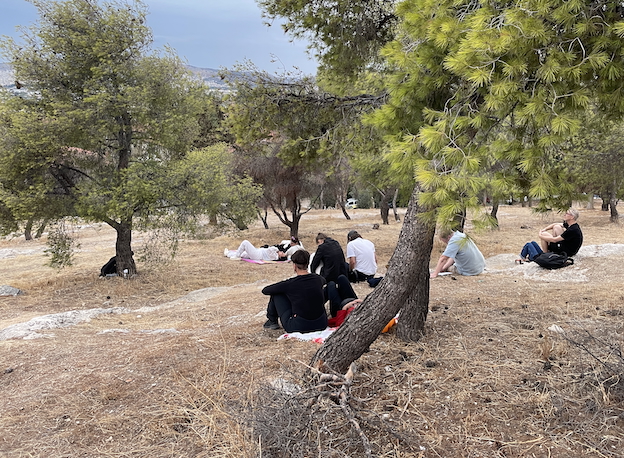
Bringing people into harmony with cosmic vibrations is at the heart of many classical Hindustani music pieces. Through the purity of sound, both performers and listeners are meant to gain a deeper understanding of themselves and the nature of existence. Since the 1960s, this concept has also fascinated and inspired artists in the West.
The atmosphere becomes minimalist and meditative when Eleh operates the knobs and patch cables of his analog modular synthesizers. The US-American musician and graphic designer from Massachusetts has been honing his skills with a variety of these instruments since 1999. The textures he generates with them, convey a feeling of precision, as if they were carved or sculpted, resulting in pieces that have cinematic or painterly qualities.

Eleh’s explorations of the relationship between sound and space culminated in the 2019 album Living Space. Compositions such as Collect Yourself/Well-arranged, pay homage to the beauty of slow changes, as they occur in all sorts of growth cycles — and they are characterised by a spiritual component that seems to be rooted in the cosmos itself.
In India, the connection between the universe and sound has long been recognised and is emphasised in Dhrupad singing, the oldest known style of classical Hindustani music. Italian-born singer Amelia Cuni was so fascinated by this concept that she traveled to India in 1978 to learn the technique herself, studying with renowned masters, among others.
In India, the connection between the universe and sound has long been recognised and is emphasised in Dhrupad singing
During her ten-year stay in the country, she performed in Mumbai, New Delhi, and internationally. Later, she actively collaborated with contemporary musicians, including her long-time partner, Berlin-based composer and creative instrument maker Werner Durand, who draws inspiration from both minimalist traditions and traditional music.
For Seconds Of Thirst, which was recorded in 2014 in a single session, the couple is accompanied by their long-time personal friend Uli Hohmann. He plays a hammered guitar and adds some subtle electronic sounds to a deep drone that unfolds from a PVC clarinet built by Durand. Above it all floats the voice of Amelia Cuni, connecting the present moment with eternity.

When Indian spiritual music became popular in New York City in the mid-1960s, one of the youngest artists around was the least impressed. Unlike the others, Charlemagne Palestine had already experienced the power of musical traditions firsthand.
Growing up in one of Brooklyn’s Jewish neighborhoods, the strong cultural and spiritual environment of the Hasidic movement shaped Palestine’s early life, as he sang as a boy soprano in the synagogue choir.
As a teenager, Palestine became the carillonneur at St. Thomas Episcopal Church down the street from the Museum of Modern Art in Manhattan in 1963. Before and after completing the short official programs, he spent hours experimenting with the tonal potential of the carillon and its bells.

And the scene listened. During the six years that Palestine played the carillon, artists such as minimalist composer Tony Conrad, blind street musician Moondog, or John Cage were regular visitors. They were obviously fascinated, but probably had no idea of the potential of the field research they were witnessing.
When Palestine turned to the piano around 1970, and after a brief period of studying electronic music with Morton Subotnick, he realised that rapid repetition of notes causes the strings to vibrate and produces overtones — most intensely on a Bösendorfer Imperial Grand Piano.
This discovery gave him the idea of composing long ritualistic pieces that had no religious reference and challenged Western audiences’ notions of beauty and meaning in music. Palestine thus became a sound shaman who created ultra special and unique sonic environments, such as with the piece Strumming Music in 1974, which went far beyond what one could imagine coming from a piano.
Featured cover art: photography by Jon Wozencroft for Eleh – Living Space (2019, Touch)
Playlist
Eleh – Collect Yourself/Well-arranged
from the album Living Space (2019, Touch)
Cuni, Durand, Hohmann – Seconds Of Thirst
recorded live in 2014 in Uli Hohmann’s studio in Bavaria (2023, Aguirre Records)
Charlemagne Palestine – Strumming Music
performed live (1974, Shandar)



Say Something